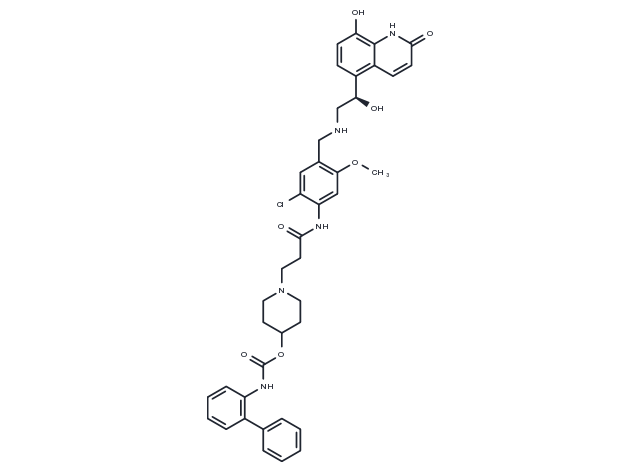Powder: -20°C for 3 years | In solvent: -80°C for 1 year


Batefenterol (TD-5959) (GSK961081, TD-5959) is a muscarinic receptor antagonist and β2-adrenoceptor agonist. It displays high affinity for hM2, hM3 muscarinic and hβ2-adrenoceptor (Ki:1.4/1.3/3.7 nM).

| Pack Size | Availability | Price/USD | Quantity |
|---|---|---|---|
| 1 mg | In stock | $ 70.00 | |
| 2 mg | In stock | $ 98.00 | |
| 5 mg | In stock | $ 148.00 | |
| 10 mg | In stock | $ 228.00 | |
| 25 mg | In stock | $ 428.00 | |
| 50 mg | In stock | $ 638.00 | |
| 100 mg | In stock | $ 892.00 | |
| 1 mL * 10 mM (in DMSO) | In stock | $ 248.00 |



| Description | Batefenterol (TD-5959) (GSK961081, TD-5959) is a muscarinic receptor antagonist and β2-adrenoceptor agonist. It displays high affinity for hM2, hM3 muscarinic and hβ2-adrenoceptor (Ki:1.4/1.3/3.7 nM). |
| Targets&IC50 | β2:3.7 nM (Ki, cell free), M3 (human):1.3 nM (Ki, cell free), M2 (human):1.4 nM (Ki, cell free) |
| In vitro | In competition radioligand binding studies at human recombinant receptors, Batefenterol displays high affinity for hM2 (Ki; 1.4 nM), hM3 muscarinic receptors (Ki: 1.3 nM) and hβ2-adrenoceptors (Ki: 3.7 nM). Batefenterol behaves as a potent hβ2-adrenoceptor agonist (EC50: 0.29 nM for stimulation of cAMP levels) with 440- and 320-fold functional selectivity over hβ1- and hβ3-adrenoceptors, respectively [1]. |
| In vivo | In the guinea pig broncho-protection assay, inhaled Batefenterol produces potent, dose-dependent inhibition of bronchoconstrictor responses via MA (ED50: 33.9 μg/mL), BA (ED50: 14.1 μg/mL), and MABA (ED50: 6.4 μg/mL) mechanisms. Significant bronchoprotective effects of Batefenterol are evident in guinea pigs via MA, BA, and MABA mechanisms for up to 7 days after dosing[1]. In guinea pig isolated trachea expressing native muscarinic M3 and β2, Batefenterol produces smooth muscle relaxation through a dual mechanism involving competitive antagonism of the M3 receptor (EC50: 50 nM) and agonism of the β2 receptor (EC50: 25 nM). The combined effect on both muscarinic receptors and β2 receptors is more potent than either function working alone (EC50: 10 nM) [2]. |
| Synonyms | GSK961081, TD-5959 |
| Molecular Weight | 740.24 |
| Formula | C40H42ClN5O7 |
| CAS No. | 743461-65-6 |
Powder: -20°C for 3 years | In solvent: -80°C for 1 year
DMSO: 100 mg/mL (135.09 mM)
H2O: < 0.1 mg/mL (insoluble)
You can also refer to dose conversion for different animals. More
bottom
Please see Inhibitor Handling Instructions for more frequently ask questions. Topics include: how to prepare stock solutions, how to store products, and cautions on cell-based assays & animal experiments, etc.
Batefenterol 743461-65-6 GPCR/G Protein Neuroscience Adrenergic Receptor AChR GSK 961081 mAChR inhibit Muscarinic acetylcholine receptor GSK961081 TD 5959 TD5959 Inhibitor TD-5959 GSK-961081 Beta Receptor inhibitor
